
Features
Applications
Beef
Stack it high
Compost pack system helps Ontario dairy reduce costs, boost production
September 23, 2010 by James Careless
Joan and Doug Cranston own Cranston Farms, a combined dairy and sweet
corn operation in Ancaster, Ont. Until recently, they kept their 40 to
45 dairy cattle in a traditional tie stall barn, a management approach
that left the cows little room to move around.
Joan and Doug Cranston own Cranston Farms, a combined dairy and sweet corn operation in Ancaster, Ont. Until recently, they kept their 40 to 45 dairy cattle in a traditional tie stall barn, a management approach that left the cows little room to move around. The barn’s solid concrete floor was hard on the cows’ hocks as well, resulting in physical injuries. Meanwhile, the manure had to be regularly cleaned out and hauled away to a solid manure storage facility.
 |
|
| A few times each year, the compost pack is cleared out, specifically when its depth reaches around four feet – the height of the barn’s outside walls. Submitted photos
|
The Cranstons were aware of the trend in dairy farming to either go bigger, or go out of business. Since they are committed farmers, they decided to expand their operation. “At the same time, we wanted to do something different that would reduce costs, cut labour and make our cows more comfortable and healthier,” says Doug. “So my son James and I spent three years looking into the options, and eventually decided on a compost pack barn.”
A compost pack barn mixes manure with sawdust, plywood/drywall shavings, or some other low-cost filler material to create a deep, thick and soft bedding for cattle. By mixing the manure and filler together, the farmer is able to dispose of the waste through the composting process right inside the barn. The high temperatures combined with regular aeration, bedding addition and mixing result in a low-odor fermenting base that ultimately can be removed and sold or used as fertilizer.
“Rather than having to clean out the stalls, we use a tractor with a chisel plough to add and then turn over the bedding once or twice a day, when the cows are being milked,” says Doug. “All of this is housed in an open concept barn – with natural light coming in through its skin, thus reducing electricity costs – rather than one divided by stalls. The cows are free to move around, congregate and generally enjoy a better, less stressed life. So they’re happy, which makes a difference when it comes to milk production and overall health.”
The compost pack system
The compost pack system – also known as a bedded pack system – starts with the filler material. The goal is to use something that is both low-cost and biodegradable. In the case of Cranston Farms, the filler is drywall crumbles and sawdust shavings, the remains of paper stripped from recycled drywall boards and the sandings from plywood manufacturing, all of which can be obtained at a rock-bottom price.
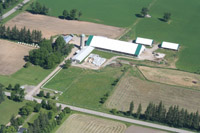 |
|
| When the Cranston family near Ancaster, Ont., decided to expand their dairy operation, they studied the options and eventually decided on a compost pack barn.
|
The initial one- to one-and-a-half-foot bed of filler is contained within a large concrete platform with four-foot outside walls. There are no concrete walls on the inside of the pack. Rollover gates on the scrape alley side of the pack allow for unobstructed airflow. The walls are vital, because the compost pack will eventually grow this tall before being removed. Some openings are left in the walls to allow the cows easy access to watering and feeding areas. The goal is to allow mobility, while also discouraging the cows from moving too fast, lest they injure themselves.
Unlike traditional barns, compost pack barns are designed to allow airflow through easy opening walls and high, well-ventilated ceilings. After all, the composting process creates a lot of waste gas that needs to be vented.
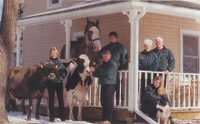
|
|
| The Cranston family have experienced great success with their compost pack barn, including winning a 2009 regional Premier’s Award for Agri-Food Innovation Excellence.
|
It doesn’t take long for the cows to deposit manure on the bedding. When they are out of the space for milking, the waste is turned under using the chisel plough. “We try to work it to a depth of 16 to 20 inches deep, adding extra drywall shavings on top to provide a drier surface,” Doug says. “The goal is to create a deep, soft bed that is dry for the cows to lay on, while the composting occurs beneath them. If the bedding gets moist, it’s time to add more filler on top.”
Aeration is the key to this process. It encourages the necessary bacterial action to break down the manure; vents the waste moisture and gas out of the bedding, and helps ensure that the topcoat remains dry – or, as Doug calls it, “crisp.”
“When the compost pack is right, it looks like dry sandy grit,” he says. “It’s not dusty and it is not damp. It is also very low odor, because this process removes about 90 percent of the smell.”
A happy cow is a productive cow
The Cranston herd lives in a “cold barn,” meaning the building is not heated during the winter months, when temperatures can go well below zero.
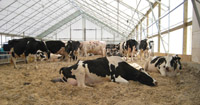 |
|
| Since shifting to the compost pack system, the Cranston family is seeing cows that are healthier and providing more milk, with fewer physical hock injuries than experienced on the farm in the past.
|
In a traditional barn, the cattle have to put up with the cold. In contrast, the 140 to 150°F fermentation process happening beneath their hooves provides some relief from the cold. In fact, it is common for the cows to dig down a bit in the bedding during the winter so that they can get warm from the compost below.
Studies have shown that cows are social animals who have a strong biological need to lie down at least 12 hours a day, and who have a preference for soft bedding. The open concept compost pack barn caters to all of these natural tendencies. It allows the cows to group together in social groups, lets them stay off their feet and keeps them comfortable.
Add the fact that the compost pack method actually reduces harmful bacteria when compared to traditional methods – because the manure is removed from contact with the cows on a regular basis, plus they have enough room to lie where manure is not directly present – and this is clearly a healthy option for cattle. Strawberry foot rot has virtually been eliminated from the Cranston herd because of the dryness of the bedding and the composting nature of the pack kills the bacteria.
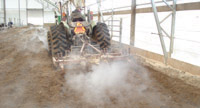 |
|
| The Cranston family tries to work the bedded pack to a depth of 16 to 20 inches, adding extra drywall shavings on top to provide a drier surface that encourages the cows to lie down.
|
According to a research study from the University of Minnesota, reported at www.extension.org, the health benefits of compost pack bedding are staggering. “Statistical analysis of historical DHIA [Dairy Herd Improvement Association] data indicated that 89 percent of the dairies had a significant increase in 305 mature-equivalent milk production when moving their cows from the previous housing system to the compost barn,” states the study, authored by Marcia Endres and Kevin A. Janni. “We found that 67 percent of the dairies had a reduction in mastitis infection rates.”
“We are seeing cows that are healthier, are not suffering the kind of physical hock injuries we used to see, and who can provide more lactation cycles during their lifetime,” says Doug. “We are also seeing better milk production and better attitude when it comes to handling them.”
At the same time, the compost pack system requires far less effort to maintain, compared to “mucking out the stalls.” It is also more pleasant work to do, especially because it can be done using a tractor and chisel plough. The pack itself only has to be cleared out when its depth reaches four feet, which is only a few times a year at most. When it is cleared out, the waste is usable fertilizer that is commercially valuable and environmentally safe.
“We sell some of it to local vegetable farmers, and the rest we put on our own fields,” he says. “There is no waste; we are taking manure and recycled drywall and shavings and creating a new product that is natural and in demand.”
Assessment
The compost pack barn approach is working well for the Cranstons. It has reduced the cost of caring for their cattle, while improving the quality of that care. Meanwhile, milk production has gone up while health problems have declined – and the cows themselves appear to be happier.
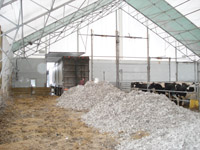
|
|
| Cranston Farms uses drywall crumbles, sawdust shavings, the remains of paper stripped from recycled drywall boards and the sandings from plywood manufacturing to bed its compost pack barn.
|
Are there any downsides? “Not really,” Doug replies. “You do have to have filler on hand, and be prepared to add it more often during wet weather. You also have to stay on top of aeration for the composting to work properly. This is not something that you can take your hands off; you have to stay on top of it.”
The irony of the compost pack system, as far as he is concerned, is its resemblance to the process of milk production. “With compost bedding and cows, the method is the same: You have to feed the gut,” he explains. “In the compost system, this means adding more manure, filler and oxygen so that the fermentation process keeps going; just like keeping cows fed so that their bodies produce milk.”